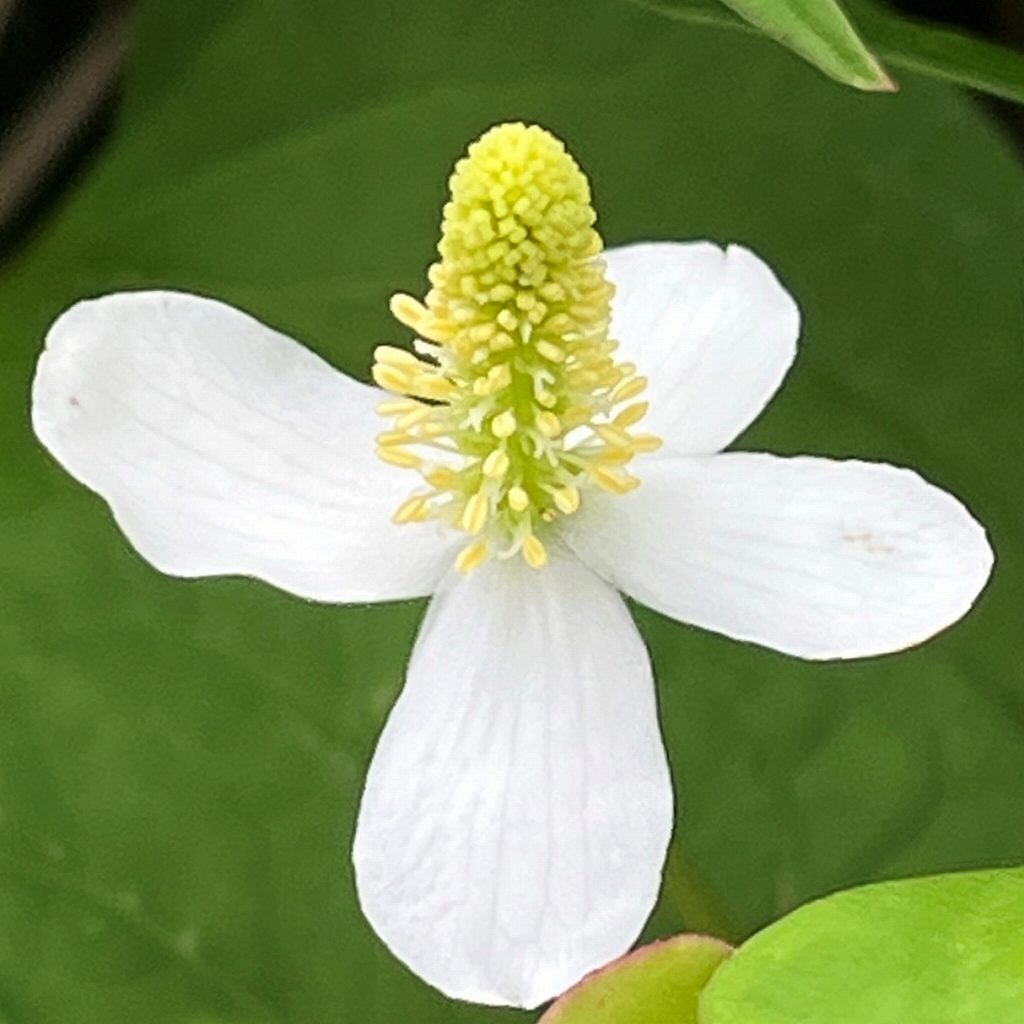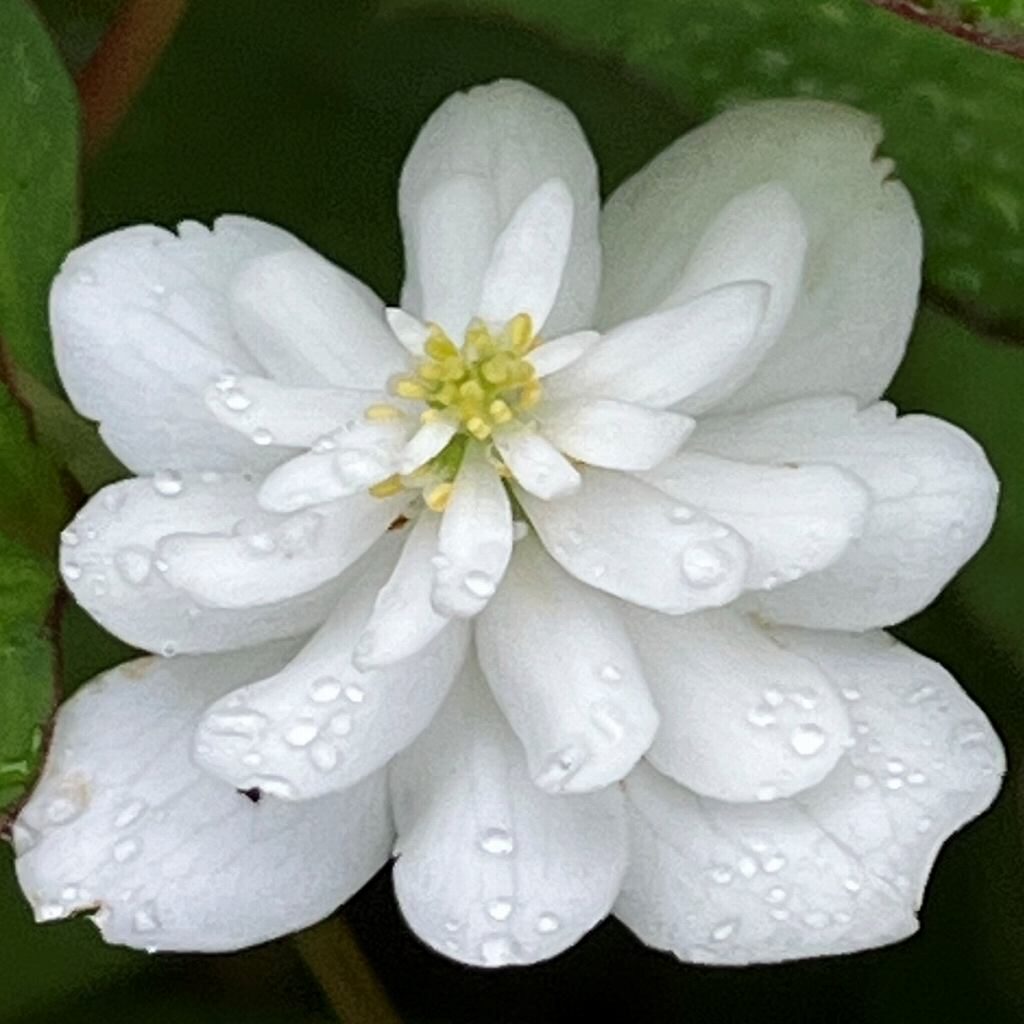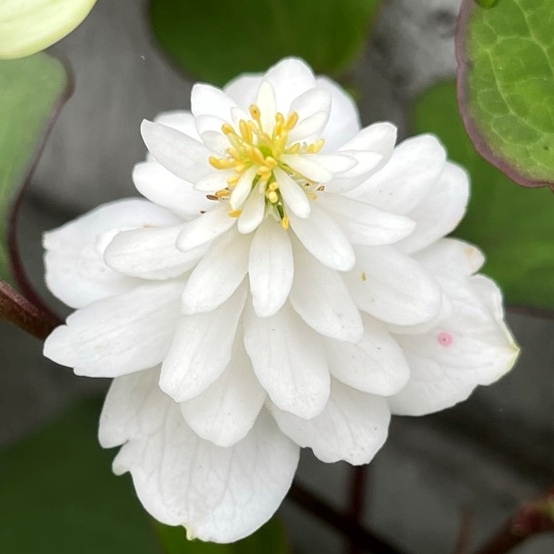ドクダミは、白い総苞片4枚が開いて十字型の花を咲かせます。真ん中の黄色い花穂は雄しべと雌しべの集合体。日本三大民間薬の1つです。
Fish mint opens four white pieces of bracts and blooms cross-shaped flowers. The yellow flower spike in the middle is a collection of male and female stamens. It is one of the three major folk medicines in Japan.
【仮名】ドクダミ, ジュウヤク
【和名】毒溜, 十薬
【英名】Fish Mint, Chameleon Plant, Fishwort
【学名】Houttuynia cordata
【誕生】05/ 15
【開花】05, 06月
【花色】White






ドクダミ
ドクダミの自生
ドクダミはドクダミ科の多年草です。原産地は東アジア。日本では北海道から本州、四国、九州、小笠原諸島まで、国外では韓国から中国、台湾、インドシナ半島、ヒマラヤ、バングラデシュまで分布しています。湿気のあるところを好んで群生。花言葉は「白い追憶」「野生」です。
ドクダミの名前
ドクダミの名前の由来は植物体の異臭により有毒を疑われて「毒溜め」。しかし実際、毒性はありません。むしろ毒や痛みを抑える生薬だから「毒痛み」「毒矯め」。外国語では英名「魚の香草」、漢名「魚臭い草」、ベトナム名「魚の野菜」など、魚にまつわるものが多いようです。
ドクダミの別名
ドクダミは別名「十薬」「十役」「重薬」です。十もの効能があって役に立ち、昔から重用される薬草だから。また、ラテン語の種名は「心臓形の」という意味で葉の形に由来。英名に「心臓形の葉」という別名もあります。さらに英名「カメレオン植物」は葉に斑が入る品種に由来。
ドクダミの茎葉
ドクダミは暖かくなると地下茎から茎葉と根を伸ばします。葉は心臓形で互生。寒くなると茎葉を枯らして地下茎で越冬します。茎葉は細胞内でアルデヒドやケトン、フラボノイド、フェノール化合物、タンニンなどの忌避・抑制物質を生成。草食動物や病害虫などから身を守ります。
ドクダミの花
ドクダミは茎先に蕾を着け、白い総苞片4枚が開いて十字型の花を咲かせます。真ん中の黄色い花穂は雄しべと雌しべの集合体。下から順に受粉して結実するものの種子は不稔性です。花は花弁も萼片もなく、総苞片と花穂だけ。総苞片は葉に由来して丈夫なので、花が長持ちします。
ドクダミの種類
ドクダミには園芸種もあります。花穂に小さな苞があり、これらが総苞片のように大きくなったものが「八重咲き」。また、葉に斑が入るものもあります。斑が5色の「カメレオン」「トリカラー」、白色の「錦」、覆輪模様の「フレーム」、黄色の「ジョーカーズ・ゴールド」など。
ドクダミの利用
ドクダミは「千振」「現の証拠」とともに日本三大民間薬の1つです。内服で胃腸病、食あたり、下痢、便秘、利尿などに、外用で腫れ物、吹き出物、皮膚病などに用いられる生薬。ベトナムでは茎葉が香草としてサラダなどで、中国の西南部では地下茎が炒め物などで食べられます。
Fish Mint
Fish mint is a perennial herb of Saururaceae family. The place of origin is East Asia. It is distributed from Hokkaido to Honshu, Shikoku, Kyushu and Ogasawara Islands in Japan, and from South Korea to China, Taiwan, Indochina Peninsula, Himalayan and Bangladesh overseas. Crowds prefer moist areas. The flower language is “white recollection” and “wild”.
The origin of the name of Fish mint is “poison reservoir” because it is suspected to be toxic due to the strange odor of the plant. But in fact, it’s not toxic. Rather, it is a raw medicine that suppresses poison and pain, so it is “poison & pain” and “suppress poison”. In foreign languages, there are many things related to fish, such as the English name “fish mint”, the Chinese name “fishy grass”, and the Vietnamese name “fish vegetables”.
Fish mint is also known as “ten medicine,” “ten uses,” and “important medicine.” It’s a medicinal herb that has ten effects, is useful, and has been used for a long time. Also, the Latin species name is derived from the shape of the leaves, which means “heart-shaped”. There is also another name in the English name, “heartleaf”. Furthermore, the English name “Chameleon Plant” is derived from a variety with spots on the leaves.
When it gets warm, Fish mint grows foliage and roots from the underground stem. The leaves are heart-shaped and alternate. When it gets cold, the foliage withers and the underground stalks overwinter. The foliage produces repellent and inhibitory substances such as aldehydes, ketones, flavonoids, phenolic compounds, and tannins in the cells. Protect theirself from herbivorous animals and pests.
Fish mint has buds on the tips of its stems, and opens four white pieces of buds to bloom cross-shaped flowers. The yellow flower spike in the middle is a collection of male and female stamens. The seeds of those that pollute and bear fruit in order from the bottom are sterile. The flowers have no petals or stalks, only total stalks and ears. The total bracts are strong because they are derived from the leaves, therefore, the flowers will last a long time.
There are also gardening species in Fish mint. There are small buds on the flower ears, and the ones that grow like total buds are “double blooms”. In addition, some leaves have spots. Five-colored spots such as “Chameleon” and “Tricolor”, white “Nishiki”, covered ring pattern “Frame”, and yellow “Joker’s Gold”.
Fish mint is one of the three major folk medicines in Japan, along with “Swertia japonica” and “Geranium thunbergii”. A raw medicine used for gastrointestinal diseases, eating, diarrhea, constipation, diuresis, etc. by internal use, and for swelling, pimples, skin diseases, etc. by external use. In Vietnam, the stems and leaves are eaten as fragrances such as salads, and in the southwestern part of China, the underground stems are eaten as fried foods.


